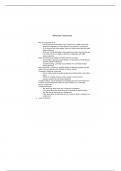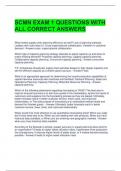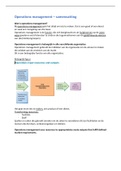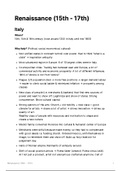,IIE Module Outline IMME5112/d/p
Module Pacer
Code Programme Contact Sessions Credits
IMME5112 BBR1; BCIL1; BDK1; BIB2; BIL1; BMA1 48 contact hours
IMME5112d BIB2d 24 contact hours
15
+ 12 learn hours
IMME5112p BIB2p 36 contact hours
Learning Unit 0 Tools for Economic Analysis
Overview:
This Learning Unit provides the opportunity for you to revise the basic principles contained
in many tools of economic analysis in microeconomics and macroeconomics.
This Learning Unit 0 is by no means a comprehensive study of mathematics. It simply revises
those mathematical principles that you will encounter in different parts of the economics
syllabus so that, when you reach those parts of the syllabus, you feel confident in applying
the mathematical principles.
© The Independent Institute of Education (Pty) Ltd 2023 Page 10 of 39
,IIE Module Outline IMME5112/d/p
Learning Unit 0
IMME5112 Tools for Economic Analysis Prescribed Material
Sessions: 1-4 (PM)
IMME5112d Learning Content: PM: Chapter 1 and
Sessions: 1-2 LO1: Illustrate a particular support material
IMME5112p relationship between two
Sessions: 1-3 variables graphically. Please note that this
Related Outcomes: LO2: Interpret existing relationships unit is a revision of basic
• N/A between economic variables principles contained in
through analysis of graphs. many tools of economic
LO3: Solve mathematical problems analysis in
involving whole numbers, microeconomics and
fractions and percentages; macroeconomics. As
• Explain the concepts such, students are also
‘ceteris paribus’ and required to self-study
‘equilibrium’. the topics in this unit
and to complete the
revision exercises.
© The Independent Institute of Education (Pty) Ltd 2023 Page 11 of 39
,IIE Module Outline IMME5112/d/p
Learning Unit 1 What is Economics All About?
Overview:
Economics encompasses the production, distribution and consumption of goods and
services in an economy, based on the behaviours, needs, wants and decisions of individuals
and groups of people. Economics can be broadly categorised into microeconomics, which
focuses on the decisions and behaviour of individuals, groups of people and businesses, and
macroeconomics, which involves the national and global economy and evaluates the various
issues and decisions at this level.
Scarcity, choice and opportunity cost are fundamental concepts to economics. It
encompasses the choices people make to satisfy unlimited wants and needs with limited
resources and the cost of choosing one alternative over the other. This can be explained by
using a production possibilities curve, which graphically illustrates all combinations of
efficient output and the combinations of output that would be inefficient or unattainable
with the given resources.
In this learning unit, we will aim to gain a better understanding of what economics is by
unpacking the term ‘economics’ and looking at why it is referred to as a social science. We
will also distinguish between microeconomics and macroeconomics and discuss the
difference between positive and normative statements in the context of economics. Later,
we will explore the production possibilities curve (PPC) to explain scarcity, choice and
opportunity cost; distinguish between efficient, inefficient and unattainable outputs; and
illustrate how changes in the quality or quantity of resources may affect output. Finally, we
will discuss some of the common mistakes made by economists with regard to correlation
and causation, as well as the difference between levels and rates of change.
Please work through Themes 1, 2 and 3 on Learn, together with the relevant sections of your
prescribed source/s. To ensure that you are working towards mastering the objectives for
this learning unit, please also ensure that you complete the activities on Learn.
Prescribed figures, boxes and tables:
Figure 1.1 to 1.4
Box 1-1, 1-2, 1-3 and 1-5
Table 1.1 and 1.2
© The Independent Institute of Education (Pty) Ltd 2023 Page 12 of 39
, IIE Module Outline IMME5112/d/p
Learning Unit 1: Theme breakdown
IMME5112 Theme 1: Introducing the concepts Prescribed
Sessions: 5-7 Material (PM)
IMME5112d Learning Content: PM: Chapter 1
Sessions: 3 LO1: Define the term ‘economics’.
IMME5112p LO2: Explain why economics is a social science.
Sessions: 4-5 LO3: Distinguish between microeconomics and
Related macroeconomics.
Outcomes: LO4: Identify positive and normative statements.
• MO1 LO5: Explain the concept of scarcity, choice and
opportunity cost with the aid of a production
possibilities curve.
Theme 2: The Production Possibility Curve
LO6: Use a production possibilities curve to
distinguish between efficient, inefficient and
unattainable combinations of output.
LO7: Illustrate by using the production possibilities
curve, how an improvement in the use of
resources or an increase in the quantity of
resources affect production.
Theme 3: Common Mistakes Economists Make
LO8: Apply critical reasoning to correlation and
causation.
LO9: Distinguish between levels and rates of change.
© The Independent Institute of Education (Pty) Ltd 2023 Page 13 of 39











